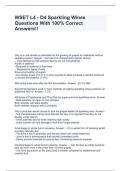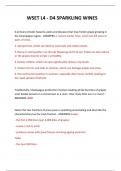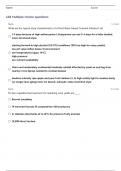L4 d4 sparkling wines - Study guides, Class notes & Summaries
Looking for the best study guides, study notes and summaries about L4 d4 sparkling wines? On this page you'll find 9 study documents about L4 d4 sparkling wines.
All 9 results
Sort by
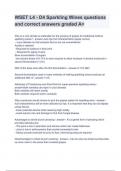 Popular
Popular
-
WSET L4 - D4 Sparkling Wines questions and correct answers graded A+
- Exam (elaborations) • 8 pages • 2023
- Available in package deal
-
- $7.99
- 2x sold
- + learn more
WSET L4 - D4 Sparkling Wines questions and correct answers graded A+
WSET L4 - D4 Sparkling Wines Questions With 100% Correct Answers!!
WSET L4 - D4 SPARKLING WINES QUESTIONS AND ANSWERS 2024
WSET L4 - D4 Sparkling Wines Questions With 100% Correct Answers!!
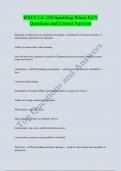
-
WSET L4 - D4 Sparkling Wines KEY Questions and Correct Answers
- Exam (elaborations) • 95 pages • 2024
- Available in package deal
-
- $7.99
- + learn more
Important considerations for sparkling wine grapes - Intensity of aromas (aromatic or neutral grape, latter better for autolytic) Ability to retain acidity while ripening How the base wine responds to autolysis (Chardonnay becomes creamy, Xarello becomes toasty and smoky) Chardonnay - Early budding and ripening => good for cold climate but vulnerable to frost Coulure & millerandage Susceptible to Powdery Mildew and botrytis bunch rot, grapevine yellows Yields can be high without ...
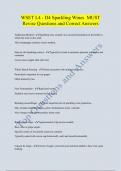
-
WSET L4 - D4 Sparkling Wines MUST Revise Questions and Correct Answers
- Exam (elaborations) • 30 pages • 2024
- Available in package deal
-
- $7.99
- + learn more
Traditional Method - Sparkling wine created via a second fermentation in the bottle in which the wine is also sold AKA champagne method, classic method, Harvest (for Sparkling wines) - Typically by hand to minimize phenolic extraction and oxidation Lower must weights than still wine Whole Bunch Pressing - Gentle extraction with minimal phenolics Particularly important for red grapes Often limited by law First Fermentation - Rapid and warm Stainless steel most common but oak foun...
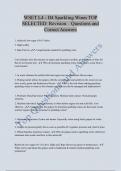
-
WSET L4 - D4 Sparkling Wines TOP SELECTED Revision Questions and Correct Answers
- Exam (elaborations) • 16 pages • 2024
- Available in package deal
-
- $7.99
- + learn more
1. relatively low sugar (10-11%abv) 2. High acidity 3. Ripe Flavors - 3 requirements needed for sparkling wine. Cool climates slow the increase in sugars and decrease in acidity, giving plenty of time for flavors to become ripe. - Why do premium sparkling wines often need to come from a cool climate? 1. In warm climates the acidity falls and sugars rise too fast before flavors ripen. 2. Picking earlier allows for grapes with the correct sugar and acidity levels, however can have overl...
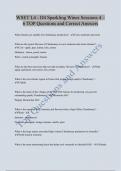
-
WSET L4 - D4 Sparkling Wines Sessions 4 – 6 TOP Questions and Correct Answers
- Exam (elaborations) • 9 pages • 2024
- Available in package deal
-
- $7.99
- + learn more
What climates are suitable for Chardonnay production? - Cool, moderate and warm What are the typical flavours of Chardonnay in cool, moderate and warm climates? - Cool - apple, pear, lemon, lime, stones Moderate - lemon, peach, melon Warm - peach, pineapple, banana What are the three processes that can add secondary flavours to Chardonnay? - Oak aging, malolactic conversion, lees contact What is the cool climate region in France that produces high quality Chardonnay? - Chablis What i...
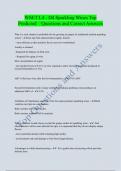
-
WSET L4 - D4 Sparkling Wines Top Predicted Questions and Correct Answers
- Exam (elaborations) • 9 pages • 2024
- Available in package deal
-
- $7.99
- + learn more
Why is a cool climate is preferable for the growing of grapes for traditional method sparkling wines? - Just ripe fruit characteristics (apple, lemon) - more delicate so that autolytic flavors are not overwhelmed Acidity is retained -Required for balance in final wine - Required for aging of wine Slow accumulation of sugars -low alcohol levels of 9-11% in wine required to allow increase in alcohol produced in second fermentation (1-2%) ABV of the base wine after the first fermentation...

Did you know that on average a seller on Stuvia earns $82 per month selling study resources? Hmm, hint, hint. Discover all about earning on Stuvia

